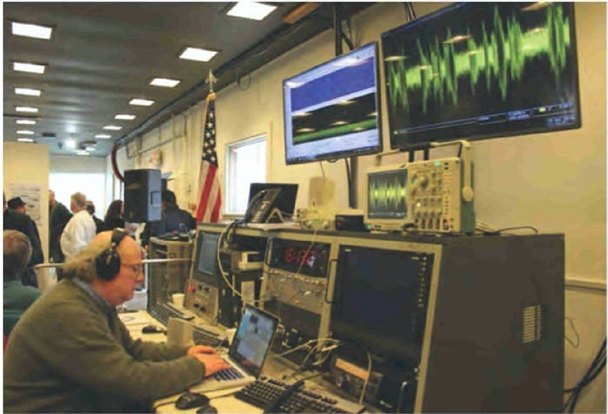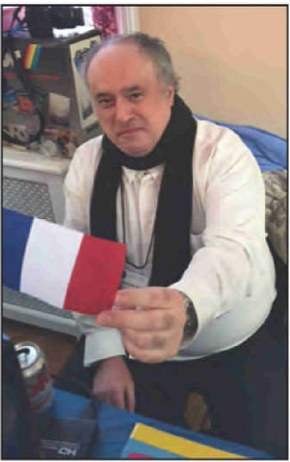
Photo A. Time-lapse photo of the TLM-18 dish antenna at the lnfoAge Museum in New Jersey. This antenna was first used to control and download images from TIROS (Television Infrared Observation Satellite) -1 and -2. Current plans are to use it for radio astronomy and 70-centimeter Earth-Moon-Earth (EME) commu nications. (Photo by and courtesy of Robert Raia Photography)
Sometimes, it’s good to get out of the shack for a while and hit the road with the family. But don’t worry, says K2YY, you don’t have to leave radio technology behind … just include it in your travel plans!
Ham Radio Road Trip
BY JOHN HILL,* K2YY
There’s a world out there beyond the ham shack. It’s the same world inhabited by the other hams we talk to on the air. And there’s a lot out there that’s interesting. Who knows? It might even interest the XYL and the harmonics. So, the next time you feel like spending the weekend burying more radials, waiting in line for country number 303, or making yet another adjustment to an antenna, pack the family in the car and take a road trip. And even if you don’t bring the mobile rig, you don’t need to stray far from ham radio and radio technology. Here are a few desti nations that you might consider…
lnfoAge
Our first stop is in north-central New Jersey, close to the shore. There are a few places, and lnfoAge is one of them, where several reasons to visit come together. lnfoAge is the former Signal Corps site Camp Evans (a part of the more widely known Fort Monmouth) and as such, houses an eclectic col lection of old military gear: Trailers, dishes which were last used in 1974, and an odd assortment of other gear that even the Signal Corps has long for gotten. It’s also the home of the Marconi Wireless Company’s Belmar Station (the address is 2201 Marconi Road), a location of great historical significance to hams. After all, he’s the one who started this wireless business.
The Wall, NJ, location of lnfoAge is also where the New Jersey Antique Radio Club holds its meetings. Three times a year, the club also holds swap meets, as well as the occasional auction where everything from the vener able Drake twins to a 1928 Atwater Kent is offered for sale. I went to one of these auctions. It’s only my increasingly hard-core position that anything that comes into the house be equaled by something leaving that kept me from coming home with my trunk full. But I wanted to buy it all.
There is also a very good onsite museum of everything radio (The Radio Technology Museum), from spark-gap transmitters, through early broadcast receivers, to television and beyond. And … an extensive collection of military electronics, including a hand cranked generator.
Down Marconi Road, a few hundred yards is a dedicated building which houses the Ocean Monmouth County Amateur Radio Club (N2MO), as well as the truly massive 60-foot dish used for early satellite communication (Photo A.). The TLM-18, serial number 1, was initially used to control the Television Infrared Observation Satellites, TIROS 1 and TIROS 2, and observe television images from them.
This was also the site used by the U.S. Army in 1946 to receive the first radio signals bounced off the moon. Daniel Marlow, K2QM (Photo B), a Princeton physics teacher, currently plans to use the dish for radio astronomy. His goals are to observe the 21-centimeter radiation from the Milky Way, as well as observe pulsars around 70 centimeters. There are also plans afoot to use this dish at432 MHz (since there will already be a 70-centimeter feed) for amateur EME (Earth-Moon-Earth, or moon bounce). With a gain of 35 dBi, that should produce a loud signal indeed.

Photo B. Daniel Marlow, K2QM, operates a special event station at lnfoAge in 2016, commemorating the 70th anniversary of Project Diana, the U.S. Army’s first moonbounce experiment, conducted from the former Fort Monmouth, currently the site of the lnfoAge museum. (Photo by and courtesy of Martin Flynn, W2RWJ/lnfoAge)
In addition, lnfoAge hosts the annual East Coast Vintage Computer Festival (Photo C). This hobby is to computer enthusiasts what using 40- (or 50-) year-old radios is to hams. There is always some overlap between com puter hobbyists and radio hobbyists, but the connection is stronger here than usual. My son, Mike, KB2EUC, has been an exhibitor there for the last sev eral years (Photo 0 ). His exhibit in 2015 was converting live video from a pair of iPhones to a Commodore Pet that was never designed for video.
And if these weren’t enough, there is also the Surfing Museum, the Garden State Central Model Railroad Club, the National Broadcasters Hall of Fame, and the New Jersey Shipwreck Museum on site.
Find a Radio Museum Near You
It’s important to remember that this is one destination among many. What I’ve been writing about is about a visit that can only be made by those who live in the Northeast – although it might be worth including in the itinerary for those planning a trip this way. There are many places like the lnfoAge Science History center around the country and, indeed, around the world.
A great resource for those hams in dif different areas is www.radiomuseum.org, which supports English as well as German, French, Spanish, and Italian. Radio museums can be located by country and U.S. state. A quick list includes The Hammond Museum of Radio (not to be confused with two similarly named Hammond Museums) in Guelph, Ontario (very ham radio ori ented with a large collection of Collins gear); The Pavek Museum of Broad casting (which contains a hamshack open from Wednesday to Saturday) in St. Louis Park, Minnesota (925-926- 8198, <contact@museumofbroadcast ing.org>); The House of Broadcasting in Scottsdale, Arizona (featuring a Buck Owens exhibit – not for everyone); the French Cable Station in Orleans, Cape Cod, Massachusetts (the U.S. end of the first cable across the Atlantic); and the truly spectacular Musee des Arts et Metiers, 60, rue Reaumur, in Paris. This museum, founded in 1794, features exhibits about technology in general, although it has occasionally had exhibits specifically about radio.
Ham Conventions

Photo C. A French exhibitor at the East Coast Vintage Computer Festival, held each year at lnfoAge. Like Ham-Fest for computer enthusiasts, it draws attendees and exhibitors from around the world. (Photos by the author, except as noted)
Major hamfests and conventions can also make good family trips. Most of the big shows offer family-friendly alternate activities or suggestions for near by visits while you’re at the hamfest. The gathering that we all know about is the Dayton Hamvention®, which features exhibits from most of the major manufacturers (and more than a few of the minor ones), as well as the con testers dinner, the DX dinner, the AMSAT dinner, and the D-Star meet and greet. The list of activities is long. It takes place every year in May in Xenia, Ohio, just east of Dayton (in 2019 it’s being held from May 17 through May 19). While you’re in the area, you can also go to the Packard Museum – a Packard dealership repurposed as a museum – as well as the U.S. Air Force Museum at nearby Wright Patterson Air Force Base.
Looking west, don’t forget PACIFICON, often held in Cupertino, California, but this year (2018) on the other side of San Francisco Bay in San Ramon. Many of the same manufacturers that have exhibited in Dayton also show up at
PACIFICON. The ARRL has a big presence there. You ‘ll find a lot of activities, including a flea market, soldering lessons (Photo E), kit building (a favorite with the Boy Scouts working on their merit badges), ham radio skydiv ing, and day-long training sessions that culminate in an official license exam.
While we’re talking about Northern California, hams might be interested in the Computer History Museum, (although it’s not really about ham radio), where you can choose between General Admission, the Super Geek Package, and the Total Geek Experience (children under 12, whether or not they’re geeks, get in free). It’s located at 1401 N. Shoreline Blvd., Mountain View, California 94043 (650-810-1010 computerhistory.org).
The Computer History Museum is the site of the West Coast iteration of the Vintage Computer Festival (they’re also held in Chicago, Atlanta, Berlin, Zurich, and Rome). It’s the perfect place to learn more about that TRS-80 you still holding on to in the basement. This year it was held on August 4-5.
The European equivalent of Dayton is Freidrichshafena’s huge ham radio get-together held annually in the German city of the same name (Photo F). In 2019 it will be held on June 21-23. Friedrichshafen is close to the German-Swiss border. In addition to the hamfest, a tourist will be rewarded by the opportunity to take a Zeppelin tour – not something you can do every day.
No matter where you live, there’s someplace close enough to visit and get another perspective on this hobby. Whether it’s ham radio as such, or a related subject like antique wire less, military radio, or computers (old and new), there’s plen ty to see. Take a trip. It will only enhance your enjoyment of this pastime.